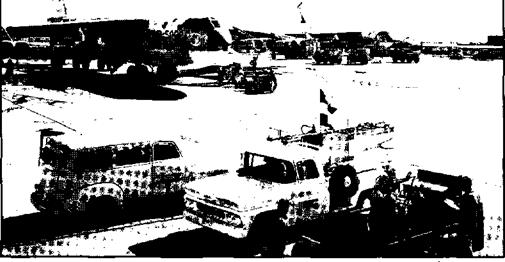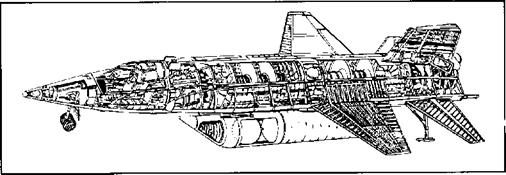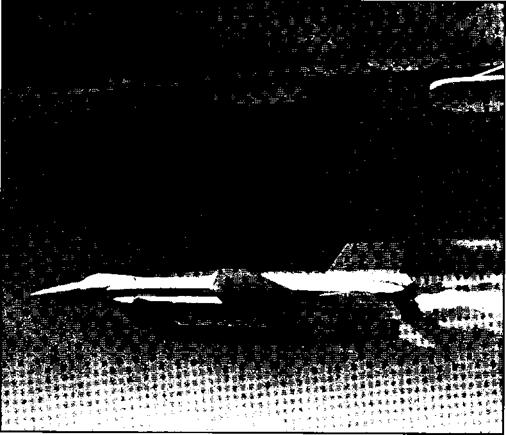Follow-on Experiments
During the summer of 1961, a new research initiative was proposed by the Air Force’s Aeronautical Systems Division at Wright – Patterson AFB and NASA Headquarters; using the X-15 to carry a wide range of sci-
![]()
 On 4 November 1960, the program attempted to launch two X-15 flights in a single day. Here X-15-1 is mounted on the NB-52B and X-15-2 is on the NB-52A. Rushworth was making his first flight in X-15-1, a low (48,900 feet) and slow (Mach 1.95) familiarization. The X-15-2, with Crossfield as pilot, aborted due to a failure in the No. 2 APU. (NASA photo E-6186)
On 4 November 1960, the program attempted to launch two X-15 flights in a single day. Here X-15-1 is mounted on the NB-52B and X-15-2 is on the NB-52A. Rushworth was making his first flight in X-15-1, a low (48,900 feet) and slow (Mach 1.95) familiarization. The X-15-2, with Crossfield as pilot, aborted due to a failure in the No. 2 APU. (NASA photo E-6186)
entific experiments unforeseen when the aircraft was conceived in 1954.
Researchers at the FRC wanted to use the X-15 to carry high-altitude experiments related to the proposed Orbiting Astronomical Observatory; others suggested modifying one of the airplanes to carry a Mach 5-f – ramjet for advanced air-breathing propulsion studies. Over 40 experiments were suggested by the scientific community as suitable candidates for the X-15 to carry. In August 1961 NASA and the Air Force formed the “X-15 Joint Program Coordinating Committee” to prepare a plan for a follow-on experiments program. The committee held its first meeting on 23-25 August 1961 at the FRC.26
Many experiments suggested to the committee related to space science, such as ultraviolet stellar photography. Others supported the Apollo program and hypersonic ramjet studies. Hartley Soule and John Stack, then NASA’s director of aeronautical research, proposed the classification of experiments into two groups: category A experiments consisted of well-advanced and funded experiments having great importance; category В included worthwhile projects of less urgency or importance.2’
In March 1962 the committee approved the “X-15 Follow-on Program,” and NASA announced that an ultraviolet stellar photography experiment from the University of Wisconsin’s Washburn Observatory would be first. The X-15’s space science program eventually included twenty-eight experiments including astronomy, micrometeorite collection (using wing-top pods on the X-15- 1 and X-15-3 that opened at 150,000 feet), and high-altitude mapping. The micrometeorite experiment was unsuccessful, and was ultimately cancelled. Two of the follow-on programs, a horizon definition experiment from the Massachusetts Institute of Technology, and test of insulation material for the Saturn launch vehicle, directly benefited the Apollo program. The Saturn insulation was applied to the X-15’s speed brakes, which were then deployed at the desired speed and dynamic pressure to test both the insulating properties and the bonding material. By the end of 1964, over 65 percent of data being returned from the three X-15 aircraft involved follow-on projects; this percentage increased yearly through conclusion of the program. ™
As early as May 1962, North American had proposed modifying one of the X-15s as a flying test bed for hypersonic engines. Since the X-I5s were being fully utilized at the time, neither the Air Force nor NASA expressed much interest in pursuing the idea. However, when the X-15-2 was damaged during a landing accident on 9 November 1962 (seriously injuring Jack McKay, who would later return from his injuries to fly the X-15 again), North American proposed modifying the aircraft in conjunction with its repairs. General support for the plan was found within the Air Force, which was willing to pay the estimated $6 million.31
On the other hand, NASA was less enthusiastic, and felt the aircraft should simply be repaired to its original configuration.32 Researchers at NASA believed that the Mach 8 X-l 5 would prove to be of limited value for propulsion research. However, NASA did not press its views, and in March 1963 the Air Force authorized North American to rebuild the aircraft as the X-15A-2. Twenty-nine inches were added to the fuselage between the existing propellant tanks. The extra volume was to be used by a liquid hydrogen tank to power the ramjet, but the LH2 tank could be replaced by other equipment as needed. In fact, the compartment was frequently used to house cameras to test reconnaissance concepts, or to observe the dummy ramjet during flight tests, through three heat-resistant windows in the lower fuselage. The capability to carry two external propellant tanks was added to provide additional powered flight with the XLR99. The right wingtip was also modified to allow various wingtip shapes to be carried interchangeably, although it appears that this capability was never used.33
Forty weeks and $9 million later, North American delivered the X-15A-2,’4 The aircraft made its first flight on 25 June 1964 piloted by Bob Rushworth. Early flights demonstrated that the aircraft retained satisfactory flying qualities at Mach 5, although on three flights thermal stresses caused portions of the landing gear to extend at Mach 4.3, generating “an awful bang and a yaw.’"5 In each case Rushworth landed safely, despite the blow-out of the heat-weakened tires in one instance. On 18 November 1966, Pete Knight set an unofficial world’s speed record of Mach 6.33 in the aircraft. The drop tanks had been jettisoned at Mach 2.27 and 69,700 feet. A nonfunctional dummy ramjet was constructed in order to gather aerodynamic data on the basic shape in preparation for possible flight tests in the early 1970s. The first flight with the dummy ramjet attached to the ventral was on 8 May 1967. Although providing a pronounced nose-down trim change, the ramjet actually restored some of the directional stability lost when the lower ventral rudder had been removed.
NASA had evaluated several possible coatings that could be applied over the X-15’s Inconel X hot-structure to enable it to withstand the thermal loads experienced above Mach 6. The use of such coatings could be beneficial since various ablators were being investigated by the major aerospace contractors during the early pre-concept phases-16 of the Space Shuttle development." Such a coating would have to be relatively light, have good insulating properties, and be easy to apply, remove, and reapply before another flight. The selected coating was MA-25S, an ablator developed by the Martin Company in connection with some early reusable spacecraft studies. Consisting of a resin base, a catalyst, and a glass bead powder, it would protect the hot-structure from the expected 2,000 degrees Fahrenheit heating at Mach 8. Martin esumated that the coating, ranging from 0.59 inches thick on the canopy, wings, vertical, and horizontal stabilizers, down to 0.015 inches on the trailing edges of the wings and tail, would keep the skin temperature below 600 degrees Fahrenheit. The first unpleasant surprise came, however, with the application of the coating to the X-15A-2: it took six weeks. Getting the correct thickness over the entire surface proved harder than expected. Also, every time a panel had to be opened to service the X-15, the coating had to be removed and reapplied around the affected area.
Because the ablator would char and emit a residue in flight, North American had installed an “eyelid” over the left cockpit window; it would remain closed until just before landing. During launch and climbout, the pilot would use the right window, but residue from the ablator would render it opaque above Mach 6. The eyelid had already been tested on several flights.™
Late in the summer of 1967, the X-15A-2 was ready for flight with the ablative coating. The weight of the ablator—125 pounds higher than planned—together with expected increased drag reduced the theoretical maximum performance of the airplane to Mach 7.4, still a significant advance over the Mach
6.3 previously attained. The appearance of the X-15A-2 was striking, an overall flat off – white finish, the external tanks a mix of silver and orange-red with broad striping. On 21 August 1967, Knight completed the first flight in the ablative coated X-15A-2, reaching Mach 4.94 and familiarizing himself with its handling qualities. His next flight was destined to be the program’s fastest flight, and the last flight of the X-15A-2.’9
On 3 October 1967, 43,750 feet over Mud Lake, Knight dropped away from the NB-52B. The flight plan showed the X-15A-2 would weigh 52,117 pounds at separation, more than 50 percent heavier than originally conceived in 1954* The external tanks were jettisoned 67.4 seconds after launch at Mach
2.4 and 72,300 feet; tank separation was satisfactory, however, Knight felt the ejection was “harder” than the last one he had experienced (2-50-89). The recovery system performed satisfactorily and the tanks were recovered in repairable condition. The XLR99 burned for
140.7 seconds before Knight shut it down. Radar data showed the X-15A-2 attained Mach 6.70 (4,520 mph) at 102,700 feet, a winged-vehicle speed record that would stand until the return of the Space Shuttle Columbia from its first orbital flight in 1981.41
The post-landing inspection revealed many things. The ability of the ablative material to protect the aircraft structure from the high aerodynamic heating was considered good except in the area around the dummy ramjet where the heating rates were significantly higher than predicted. The instrumentation on the dummy ramjet had ceased working approximately 25 seconds after engine shutdown, indicating that a bum through of the ramjet/pylon structure had occurred. Shortly thereafter the heat propagated upward into the lower aft fuselage causing the hydrogen – peroxide hot light to illuminate in the cockpit. Assuming a genuine overheat condition, William Dana in the NASA 1 control room had requested Knight to jettison the remaining peroxide. The high heat in the aft fuselage area also caused a failure of a helium check valve allowing not only the normal helium source gas to escape, but also the emergency jettison control gas supply as well. Thus, the remaining residual propellants could not be jettisoned. The aircraft was an estimated 1,500 pounds heavier than normal at landing, but the landing occurred without incident.
wave impinged on the ramjet and its supporting structure. The heat in the ramjet pylon area was later estimated to be ten times normal, and became high enough at some time during the flight to ignite 3 of the 4 explosive bolts holding the ramjet to the pylon. As Knight was turning downwind in the landing pattern, the one remaining bolt failed structurally and the ramjet separated from the aircraft. Knight did not feel the ramjet separate, and since the chase aircraft had not yet joined up, was unaware that the ramjet had separated.
The position of the X-15 at the time of separation was later established by radar data and the most likely trajectory estimated. A ground search party discovered the ramjet on the Edwards bombing range. Although it had been damaged by impact, it was returned for study of the heat damage.
The unprotected right-hand windshield was, as anticipated, partially covered with ablation products. Since the left eyelid remained closed until well into the recovery maneuver, Knight flew the X-15 using on-board instruments and directions from William Dana in the NASA 1 control room. The eyelid was opened at approximately Mach 1.6 as the aircraft was over Rogers Dry Lake, and the visibility was considered satisfactory. Knight landed at Edwards 8 minutes and 12 seconds after launch.
 |
 |
Engineers had not fully considered possible shock interaction with the ramjet shape at hypersonic speeds. As it turned out, the flow patterns were such that a tremendous shock
The ablator obviously was not totally successful; in fact this was the closest any X-15 came to structural failure induced by heating. Postflight inspection revealed that the aircraft was
charred on its leading edges and nose. The ablator had actually prevented cooling of some hot spots by keeping the heat away from the hot-structure. Some heating effects, such as where shock waves impinged on the ramjet had not been thoroughly studied. To John Becker the flight underscored.. the need for maximum attention to aerothermodynamic detail in design and preflight testing.”42 To Jack Kolf, an X-15 project engineer at the FRC, the post-flight condition of the airplane “… was a surprise to all of us. If there had been any question that the airplane was going to come back in that shape, we never would have flown it.”1-1
Some of the problems encountered with the ablator were nonrepresentative of possible future uses. The X-15 had been designed as an uninsulated hot structure. Any future vehicle would probably be designed with a more conventional airframe, eliminating some of the problems encountered on this flight. But some of the problems were very
real. The amount of time it took to apply the ablator was unacceptable. Even considering that the learning curve was steep, and that after some experience the time could be cut in half or even further, the six weeks it took to coat the relatively small X-15 bode ill for larger vehicles. Nevertheless, ablators would continue to be proposed on various Space Shuttle concepts, in decreasing quantity, until 1970 when several forms of ceramic tiles and metal “shingles” would become the preferred concepts.44

 |
It was estimated that repairing the X-15A-2 and refurbishing the ablator for another flight near Mach 7 would have taken five weeks. The unexpected airflow problems around the ramjet ended any idea of flying it again. NASA sent the X-15A-2 to North American for general maintenance and repair, and although the aircraft returned to Edwards in June 196S, it never flew again. It is now on exhibit—in natural black finish—at the Air Force Museum, Wright-Patterson AFB, Ohio.
Ultimately, Garrett did deliver a functioning model of the ramjet, and it was successfully tested in a wind tunnel in late 1969. In this case successful meant that supersonic combustion was achieved, although for a very short duration and under very controlled and controversial conditions.45










